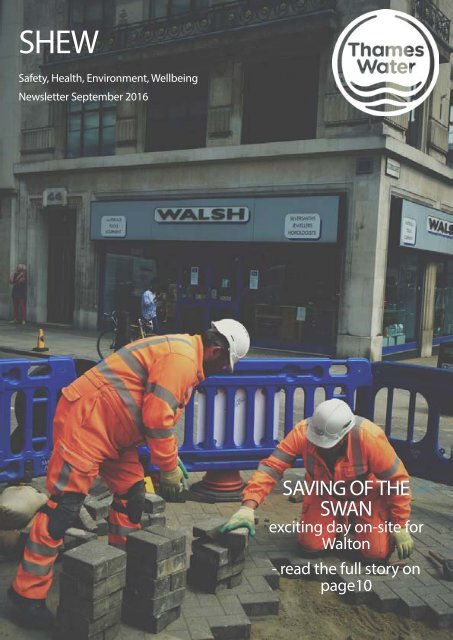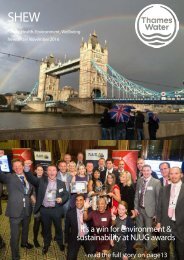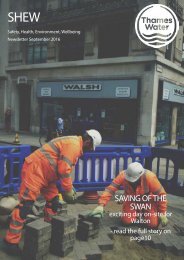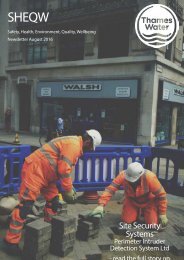SHEQWs Newsletter September
You also want an ePaper? Increase the reach of your titles
YUMPU automatically turns print PDFs into web optimized ePapers that Google loves.
SHEW<br />
Safety, Health, Environment, Wellbeing<br />
<strong>Newsletter</strong> <strong>September</strong> 2016<br />
SAVING OF THE<br />
SWAN<br />
exciting day on-site for<br />
Walton<br />
- read the full story on<br />
page10
Contents<br />
3. What we could do better<br />
Utilising Vacuum Excavators<br />
4. Press recognition<br />
Press recognition for H&S excellence<br />
5. In the Courts<br />
Looking at latest environmental<br />
prosecution<br />
6. Topic of the Month<br />
Managing Dust & Air Quality<br />
8. In the spotlight<br />
Look at how Blythe Road achieved<br />
Health, Safety, Environment & Customer<br />
excellence<br />
10. What’s been happening<br />
We look at how Waltan saved local<br />
wildlife and how the occupational health<br />
team are enhancing awareness<br />
12. Cygnus Firefly<br />
We look at how one project reduced<br />
carbon and costs through a hybrid<br />
generator<br />
15. SMB reporting<br />
Latest SHE statistics<br />
16. Safety alerts<br />
Latest safety alerts for dissemination<br />
What we<br />
could do better<br />
Utilising Vacuum<br />
Excavators<br />
What is a Vacuum Excavator?<br />
A vacuum excavator is a high power suction system used<br />
to excavate soils directly into a machine as opposed to<br />
traditional methods of machinery and hand held tools.<br />
Almost 200m of insertion work can be excavated in<br />
one day, whilst maintaining a clean tidy site, pedestrian<br />
access and 2 way traffic.<br />
It is typically a safe means of excavating for new and<br />
around existing underground utilities in any ground<br />
conditions, but has a wide variety of other applications.<br />
Why use it?<br />
• Reduces the risk of damaging utilities and underground<br />
assets<br />
• Reduces excavation sizes by up to a third compared to<br />
use of a mini-digger – reducing disposal costs and lorry<br />
movements (costs and carbon footprint)<br />
• No excess spoil- no danger of contamination into surface waters<br />
or drains<br />
• Increased productivity due to reduced manual handling<br />
• Self-contained which can tip up to 12m3 in one area, creating a<br />
cleaner environment<br />
• Increased operational safety due to less need for access and<br />
egress<br />
• Less manual effort, avoidance of strains and sprains to<br />
operatives.<br />
• Faster and more efficient excavation compared to traditional<br />
manual methods – projects are completed far quicker which<br />
results in minimal disruption to the customer, members of the<br />
public, and the environment.<br />
• Minimised damage to tree roots as the vacuum can remove the<br />
ground between them<br />
• Reduction of grab loader time on site, minimising disruption to<br />
customers and local traffic and significant reduction in third party<br />
damages.<br />
Page 2 | August 2016 SHEWQ <strong>Newsletter</strong><br />
SHEWQ <strong>Newsletter</strong><br />
August 2016 | Page 3
eight2o recognised in press for H&S<br />
approach to eliminating injuries<br />
In the courts<br />
Water Company fined £465,000 for pollution incidents<br />
The water industry is known to have a spike in injuries in the first year of<br />
construction due to the sheer volume of work undertaken. However we have<br />
been recognised as breaking new ground and offering valuable lessons for<br />
other major projects. Looking sixteen months into construction it has been<br />
acknowledged that our data on lost time injury rate paints a remarkable<br />
picture.<br />
From the outset, we agreed that health and safety would be an underpinning<br />
key outcome in the successful delivery of the entire construction programme, .<br />
We have also earned Thames Water the accolade of ‘client of the year’ at the<br />
National Construction News Awards on 14 July.<br />
For the full article click here<br />
“Early contractor involvement has<br />
been talked about for a long time but<br />
in addition to this equally as important<br />
is how we set up the contractual<br />
agreement in the correct way,”<br />
A water company has been fined<br />
£426,000 along with Environment<br />
Agency costs of £38, 642 for<br />
repeatedly polluting a watercourse<br />
with sewage.<br />
On three separate occasions<br />
blockages occurred in a combined<br />
sewer causing a build up of fat.<br />
This resulted in a back-up. The raw<br />
sewage then leaked into a surface<br />
water drain that led to a brook<br />
The fine came after the judge stated<br />
that there was a known pollution risk,<br />
which the company had failed to be<br />
proactive about.<br />
Additionally, the company had a<br />
history of repeat offences, with<br />
40 fines and convictions between<br />
2000 and 2015 for failing to prevent<br />
pollution and failing to meet permit<br />
conditions.<br />
As a result of this fine, the company<br />
are now carrying out frequent<br />
.observations of the sewer.<br />
The scale of the fines sends out a<br />
clear message that it is far more cost<br />
effective to implement measures to<br />
prevent these incidents occurring in<br />
the first place.<br />
(The Environmentalist, 2016)<br />
Page 4 | August 2016 SHEWQ <strong>Newsletter</strong><br />
SHEWQ <strong>Newsletter</strong><br />
July 2016 | Page 5
Managing Dust & Air Quality<br />
Pollutants associated<br />
with the our works include;<br />
• Airborne particulates (associated<br />
with health impacts as they are<br />
inhalable)<br />
• Dust (associated with nuisance<br />
and amenity impacts due to the<br />
visibility)<br />
• Gaseous pollutants such as<br />
NOx, SO2, CO and benzene from<br />
plant, machinery and other<br />
construction vehicles.<br />
Why should we minimise<br />
dust and maintain a high air<br />
quality?<br />
• Avoid nuisance to neighbours:<br />
Dust can settle on neighbours’<br />
properties and give rise to<br />
local dispute. Poorly controlled<br />
emissions and odours from plant<br />
or works may give rise to valid<br />
complaints.<br />
• Avoid programme delays: The<br />
Local Authority has the power<br />
to stop works if dust is causing a<br />
nuisance. Emission of dark smoke<br />
from plant and fires is illegal.<br />
• Avoid health problems: Dust<br />
may cause eye irritation or make<br />
asthma worse<br />
• Avoid impact on ecology: Dust<br />
can damage the ecology of a<br />
watercourse and affect plant<br />
growth<br />
How can we avoid causing nuisance from dust & remain complaint;<br />
• Keep roads swept and damp down with water at regular intervals<br />
• Minimise drop heights into haulage vehicles and into conveyors<br />
• Ensure cutting and grinding operations are adequately shielded or wetted<br />
• Sheet lorries carrying dry materials off site<br />
• Keep to site speed limits to minimise dust generation<br />
• Store fine, dry materials within buildings or provide adequate protection from the wind.<br />
• Position stockpiles away from residential areas or watercourses.<br />
• Notify your Supervisor and Environmental Team if work activities are causing dust.<br />
• Inform your Environmental Advisor immediately if you receive any complaints<br />
• DON’T use chemical dust suppressants without the consent of the Environment Agency<br />
• DON’T take water from a watercourse for use in dust suppressing unless an abstraction licence is in place<br />
Page 6 | August 2016 SHEWQ <strong>Newsletter</strong><br />
SHEWQ <strong>Newsletter</strong><br />
August 2016 | Page 7
In the spotlight<br />
Blythe Road Mains Rehabilitation Project<br />
Environment<br />
• Early soil sampling ruled out contaminated<br />
land, removing the need for barrier pipe<br />
• Works were in a conservation area and so the<br />
team avoided root protection zones. Liaison<br />
with the councils Tree Officer was essential,<br />
especially following a non-eight2O incident<br />
where a lorry reversed into a tree<br />
• Works involved working weekends and<br />
till 7pm weekdays and so a Section 61 was<br />
obtained . Noisy activities were always restricted<br />
to core hours as far as possible and were<br />
avoided on Sundays.<br />
• The team operated under a Permit to Pump<br />
and used silt socks when dewatering<br />
• Compass Archaeology undertook a watching<br />
brief and the Site Agent ensured they came out<br />
at the optimum time (i.e. when the maximum<br />
number of holes were open), to optimise the<br />
visit.<br />
DISCOVERY- whilst<br />
onsite, some 19th<br />
century pottery<br />
was found in the<br />
made ground/<br />
backfill and a 19th<br />
century brick wall<br />
base, possible from<br />
the original Blythe<br />
House. – this shows<br />
that finds can even<br />
occur in the most<br />
disturbed areas.<br />
Overview<br />
As so many projects in the London Streets, the team working in Blythe Road were given a window of opportunity to install a new water pipe along<br />
the length of the road before the Olympia Centre ran its next event which has a major effect on the surrounding roads including Blythe Road.<br />
Health, Safety, Wellbeing<br />
• Reducing the risk of traffic to gangs: road<br />
closures were used with strongwall fencing<br />
providing security to the work areas and<br />
preventing unauthorised entry.<br />
• Well managed workplace with a fully engaged<br />
work force that take pride in the standard of<br />
work they produce and work safely without<br />
cutting corners to produce a good job.<br />
• The work was planned to utilise the open cut<br />
method, but following trial holes, a disused gas<br />
main was discovered, which was of the right size<br />
to insert the water pipe in and so it was agreed<br />
by National Grid that this could be used. which<br />
reduced disruption.<br />
- Ensuring the road was “constantly in supply”<br />
meant the use of over ground riders<br />
- Particular attention was given to ensuring<br />
the old National Post Office Savings building<br />
remained in supply as it holds millions of<br />
pounds of additional exhibits from the Natural<br />
History and V&A museums.<br />
- Vacuum Excavator used to minimise disruption<br />
and reduce risks of striking utilities<br />
Customer<br />
• Letter drops and drop-in sessions held in<br />
advance of works<br />
• Meetings with local stakeholders such as<br />
Olympia to discuss works timetable to minimise<br />
disruption<br />
• Local businesses updated throughout works to<br />
minimise disruption<br />
• Signage displayed explaining the works and<br />
apologising for any inconvenience caused<br />
Page 8 | August 2016 SHEWQ <strong>Newsletter</strong><br />
SHEWQ <strong>Newsletter</strong><br />
August 2016 | Page 9
What’s been happening across<br />
eight 2<br />
O<br />
THE SAVING OF THE SWAN<br />
TO BE…Walton’s GF has<br />
great luck with local birds.<br />
In August, the Walton Advanced<br />
Water Treatment works team were<br />
faced with a wildlife rescue mission<br />
at its finest.<br />
Leading up to the event the team<br />
had been observing a Swan’s nest<br />
in a disused filter bed on site. The<br />
mating Swan pair laid a total of 5<br />
eggs of which 4 hatched.<br />
The site team watched the four<br />
Cygnets grow over the weeks<br />
and observed them gradually<br />
venturing further away from their<br />
nest. Unfortunately overnight the 4<br />
Cygnets reduced to 3.<br />
On the morning of the rescue, the<br />
site team noticed that 2 Cygnets,<br />
mum and dad were trapped in the<br />
inlet channel.<br />
The General Foreman Kevin<br />
Etherington was given the job of<br />
holding one of the rescued Cygnets<br />
in the attempt to try and coax the<br />
dad within reach so that he could<br />
also be pulled out of the inlet.<br />
After the successful recover, the site<br />
released the family of 4 back into the<br />
River Thames. The site team are still<br />
able to see them most days coming<br />
past the pontoons and barges and so<br />
can keep a beedy eye on them.<br />
A special thanks goes to Kevin<br />
Etherington for sharing this story<br />
with us.<br />
We think that you will all agree that<br />
these lucky swans to be are no ugly<br />
duckings!<br />
Occupational Health on the<br />
road<br />
It has been a busy month for<br />
eight2O’s occupational health people.<br />
They have met with 178 staff offering<br />
health checks, health surveillance and<br />
health promotion talks on Work Life<br />
Balance, migraine, shift working and<br />
fatigue.<br />
There has been a really good response<br />
from everyone they’ve met, and more<br />
visits are planned as we move into the<br />
autumn.<br />
Focus on tiredness and<br />
fatigue- key messages<br />
• Consider fatigue when planning<br />
work and shift patterns.<br />
• Complete a risk assessment to<br />
review the effects of fatigue on work<br />
activities.<br />
• Plan work so that no one is<br />
scheduled to work more than 12<br />
hours (excluding handover time). If<br />
someone is to work longer than 12<br />
hours, a discussion is needed with<br />
their manager and an assessment is to<br />
be conducted.<br />
• Stand down anyone who shows<br />
signs of fatigue.<br />
• Empower employees to stop work if<br />
they become tired and fatigued.<br />
Acting quickly, they phoned a local<br />
swan sanctuary who came to site<br />
and managed to pull mum and both<br />
sygnets out to safety.<br />
Page 10 | August 2016 SHEWQ <strong>Newsletter</strong><br />
SHEWQ <strong>Newsletter</strong><br />
August 2016 | Page 11
August’s SMB Reporting Figures<br />
The OneView app effectively replaces cumbersome stat packs with a cloud-based document management/viewer<br />
system. And the photo-driven Corona app provides real-time H&S reporting and the backbone for the Works<br />
Management System.<br />
97%<br />
63%<br />
Cygnus Firefly: Clean energy<br />
Use on Manor Road, Wantage works<br />
Manor road is nestled within the<br />
heart of Wantage with a bustling<br />
local community and lots of local<br />
amenities (including bowling<br />
club, park, primary school and<br />
leisure centre), which are all in<br />
close proximity to the works<br />
location, site offices and welfare<br />
facilities.<br />
To mitigate potential noise and<br />
vibration issues to the local area,<br />
Trant Engineering Ltd explored<br />
alternative options for power<br />
source.<br />
The Firefly silent hybrid<br />
power system proved to<br />
be a viable solution since it<br />
provided;<br />
• Efficient power supply onsite<br />
• Reduced noise, CO2 and<br />
emissions<br />
• Increased power system uptime<br />
• CO2 savings reportsed<br />
• Reduced and controlled fuel<br />
costs<br />
“Reducing diesel<br />
generator run time by<br />
using a hybrid power<br />
system reduces pollution<br />
and noise. Particularly<br />
overnight and at<br />
weekends when a site<br />
power is usually very<br />
low, noise is frequently a<br />
problem”<br />
100%<br />
Diversion of Excavated Material<br />
from landfill vs Target<br />
51<br />
3<br />
Noise<br />
Asbestos<br />
Trip or slip hazard<br />
1<br />
1<br />
2<br />
90%<br />
Recycled aggregate use<br />
It is the responsibility of the construction team<br />
to ensure that our subcontractors are using<br />
facilities which maximise recycling.<br />
Every month reporting data is extracted from<br />
Safeguard and the BB Hotline.<br />
Whether a service strike, incident, near miss or<br />
hazard, it is all incredibly important to us.<br />
Near miss - utility<br />
“The Cygnus® range includes a timer<br />
function that allows the site operator to<br />
ensure that critical power systems are<br />
maintained, whilst eliminating noise<br />
and improving the local environment<br />
for the local community.”<br />
170<br />
Completed H&S Inspections<br />
Please ensure that you are completing your<br />
inspections on safeguard. These are crucial in<br />
identifying hazards and reducing the risk of an<br />
incident on site.<br />
We are getting better ... but we are not<br />
reaching our target yet!<br />
Page 12 | August 2016<br />
SHEWQ <strong>Newsletter</strong><br />
SHEWQ <strong>Newsletter</strong><br />
August 2016 | Page 13
SAFETY ALERTS<br />
PROTECTING OF<br />
ABOVE GROUND<br />
SERVICES<br />
UNSAFE CABLE<br />
CUTTING<br />
Select each safety alert to download to your device. If you<br />
are briefing out to your colleagues download DW01F04, fill<br />
out and return to the H&S safety team.<br />
DW01F04<br />
MANUAL<br />
HANDLING<br />
HIGH VOLTAGE<br />
CABLE STRIKE<br />
CCTV SURVEYS<br />
& CONFINED<br />
SPACES<br />
Page 14 | May 2016 Take care<br />
May 2016 | Page 15
Passionate about everything we do
















